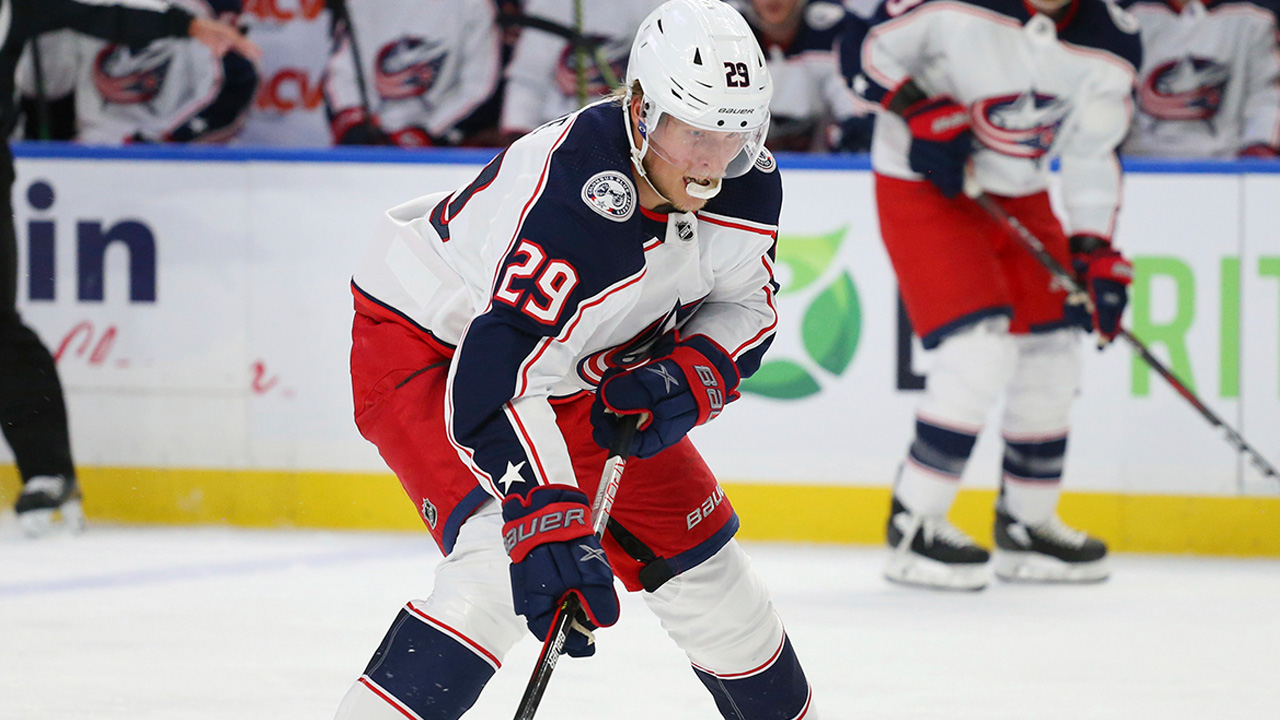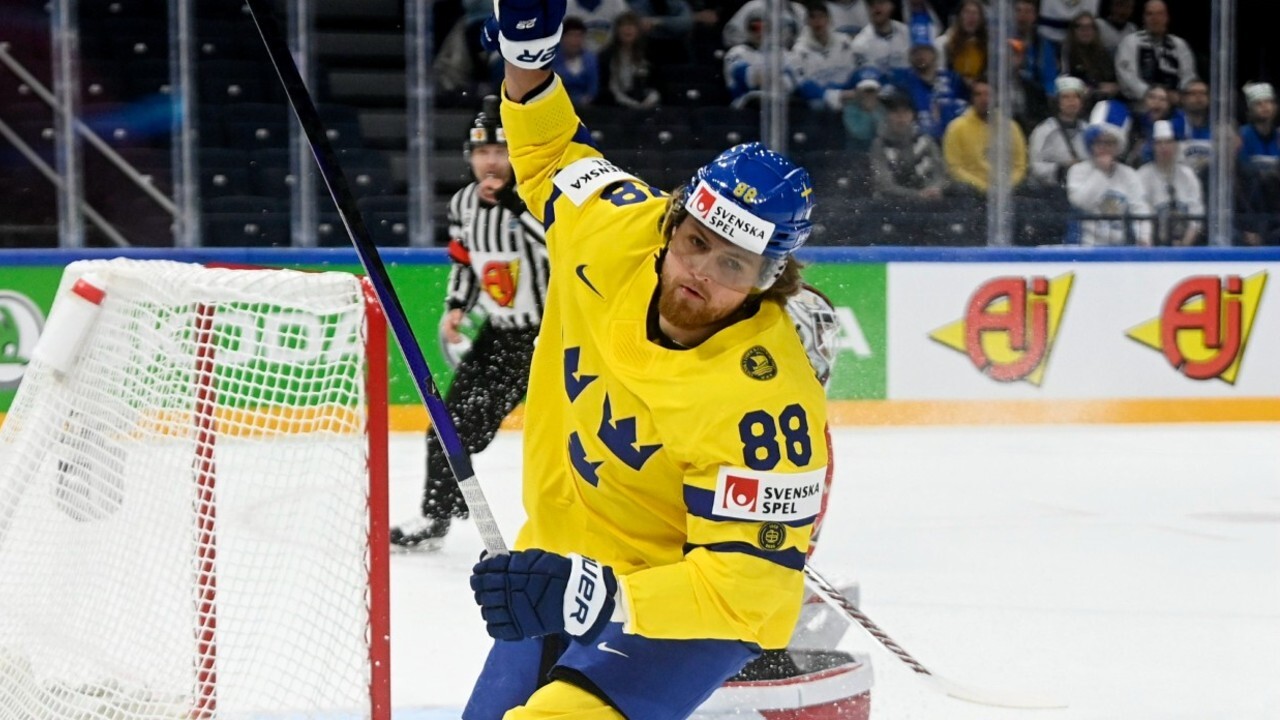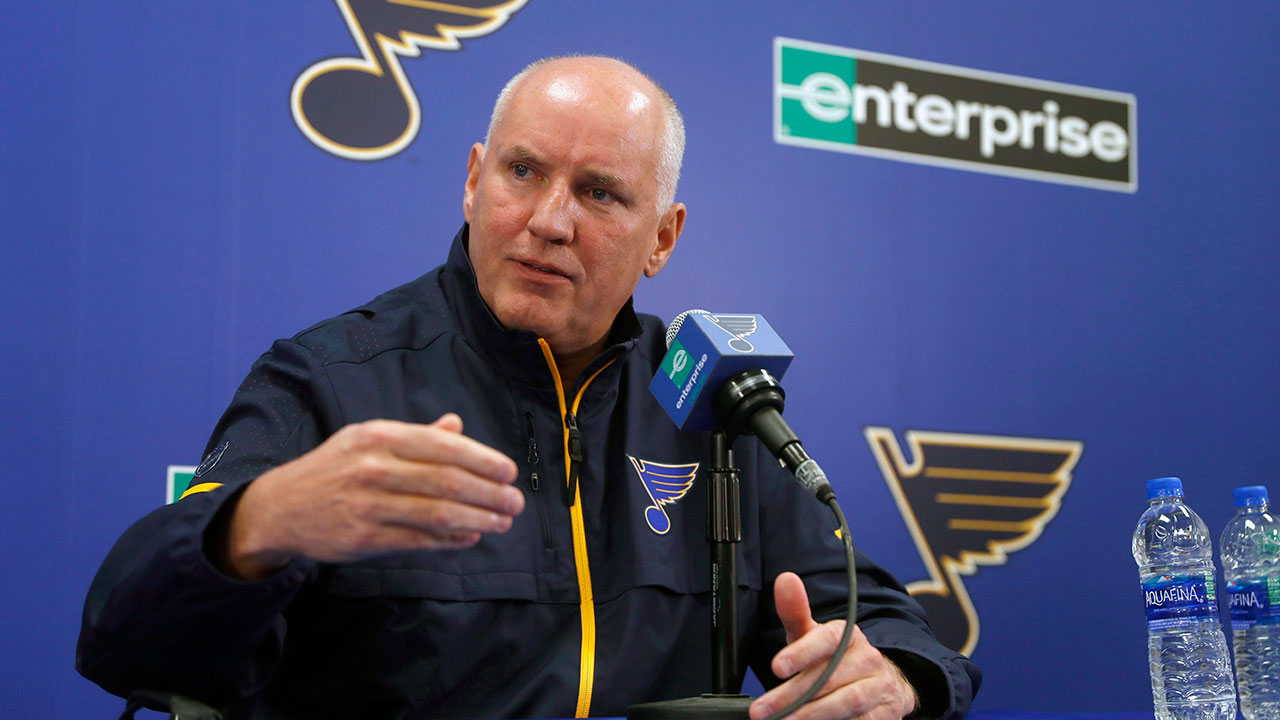
The Friday Four, a collection of thoughts and information on some intriguing player performances, continues this week with notes on:
• Columbus’ impossible Patrik Laine decision.
• Is Ville Husso creating a goalie controversy in St. Louis?
• Why Kaapo Kahkonen could make the Seattle Kraken regret taking a pass.
• And the Pittsburgh Penguins’ wager that Jeff Carter will lift the Stanley Cup again.
PATRIK LAINE, COLUMBUS BLUE JACKETS
GM Jarmo Kekalainen faces an almost impossible decision here. Laine, acquired for centre Pierre-Luc Dubois just over a year ago, will be an arbitration-eligible RFA this summer. That leaves the Blue Jackets with three options:
• Go through arbitration and end up with a one-year extension that would walk Laine to unrestricted free agency in 2023 as a 25-year-old.
• Extend Laine for multiple years, which would, in theory, also require a significant investment of cap dollars. Laine has a $7.5-million AAV this season that makes him the second-highest paid player on the team.
• Trade him.
There are no obvious plays here. Option 1 brings a high degree of risk that the player becomes a must-trade by next year’s deadline if he’s not going to sign long-term, or if the dollars don’t make sense for both sides. At that point, it would be hard to envision the Blue Jackets getting assets back that compare to Dubois.
Option 2 was the hopeful end point coming into this season, but Laine’s play hasn’t made that easy to do. He has scored 16 goals in 67 games for the Blue Jackets. That is a far cry from the 30-40-goal man Laine was acquired to be.
Last season was bumpy for both Laine in Columbus and Dubois in Winnipeg, but in a full season within these lineups, we could reasonably expect both to bounce back. Dubois certainly has, but Laine’s road has continued to be bumpy. He scored three goals in his first nine games, and then was sidelined with an oblique injury for nearly two months. His dad also passed away and we can’t overlook the impact that would have on a personal level.
But a financial decision is going to have to be made by the Blue Jackets and, on the ice, Laine is trending in the wrong direction since returning to the lineup on Dec. 30, with three goals in 13 games.
“Yeah, I think he’s fallen off here, there’s no question,” Blue Jackets head coach Brad Larsen told The Athletic’s Aaron Portzline this week. “I’m trying to let him work through it. We’ve had some good talks, and I’ll just leave it at that. We’re going to work our way through this and I mean we’re going to work through it the right way. We’re not going to go down the (same) path (as) last year. We’ve had deep discussions about where it got to, and I don’t think he wants to get there again. It is my job now to help him through that. If it gets uncomfortable, if it gets hard, that’s OK. But I want to help him grow as a player, and we need him, so he will put the work in and he’s going to get back to where we need him to get to.”
Laine may be unlocked again playing next to a legitimate No. 1 centre the Blue Jackets can’t provide, but it’s worth pointing out that Columbus did try to complement his shooting ability by trading for right winger Jakub Voracek’s playmaking over the summer. That hasn’t done it, though, and amazingly Laine doesn’t even have a single power-play goal yet. The two were split up on even-strength lines this week.
Whether Laine signs for max term (or close to it), or extends for something shorter (say, two to four years), the cap commitment would still figure to be substantial. At least $7.5 million, given the market and Laine’s free agency track. It’d be an investment on his reputation, past production and a bet that he finds himself again. If he explodes again in the coming weeks, this choice could still crystallize.
And, yes, the Blue Jackets need scoring power, but they also can’t afford to waste a good chunk of cap space on the potential of it. If Laine never comes all the way back, that’ll be a long-term problem.
That brings us to Option 3 and the possibility of a trade either before this year’s deadline, or possibly in the off-season. In Jeff Marek’s latest Rink Fries piece looking at 10 interesting trade candidates, Laine shows up as the wild card. Can he bring Columbus back a collection of assets that’d become equal or greater than Dubois? You’d think there’d be a buyer out there willing to pay up and gamble on Laine’s unique goal-scoring ability coming all the way back, and investing in his marketable star power. But with the cap still so tight and most teams up against the limit, the question of how much to pour into him now will be a tough one for a lot of organizations.
“This is a really tough situation for the Blue Jackets because this is a 23-year-old player with sublime talent,” Portzline told Sportsnet 650’s Boomer in the Morning this week. “That’s the kind of guy typically you’d want to put your arms around and have him be part of your rebuild, which you’re undergoing. But I don’t know where it goes with him.
“This is a huge decision. I think he’s a decision that hasn’t quite been made yet. But you talk about big trade chips for a rebuilding team, that’s your difficult call, what to do with this player.”
[radioclip id=5280180]VILLE HUSSO, ST. LOUIS BLUES
It’s a shame NHLers aren’t going to the Olympics for a variety of reasons, and to me one of the more interesting situations we won’t get a window into is just how Canada’s goalies would have played out.
At this point, Marc-Andre Fleury must have been a lock for the team because he’s been the best performer. Jordan Binnington figured to be high up in the running as well, but he’s been slipping for a few weeks now in St. Louis and it’s begun to open the question: Do the Blues have a burgeoning goalie controversy?
It’s quite fascinating. In one corner you have Binnington, the 28-year-old No. 1 with a $6-million cap hit and a six-year contract that only just started this season. Binnington was a third-round pick in 2011 and came out of nowhere mid-season three years ago to post a .927 regular-season save percentage and help get the Blues their first Stanley Cup.
In the other corner you have 26-year-old Ville Husso, a fourth-round pick in 2014 and one-time goalie of the future for the Blues. His NHL progress has been slow to come and he didn’t have any month last season in which he posted a .900 save percentage. Interestingly, in 2018-19 when Binnington was given his opportunity, Husso was out with a high-ankle sprain. Had he been healthy at the time, perhaps he would have been given the first shot.
The overall numbers for the two ‘tenders this season are overwhelmingly in Husso’s favour. Looking just at recent trends in January, Husso is earning more and more play.

Husso has been the best NHL goalie this month and earned second star of the week honours. Meantime, Binnington has allowed more than three goals in half of his past 14 starts, dating to Nov. 11.
“Is there a controversy? I think we’re early in that,” Darren Pang said on The Jeff Marek Show. “I think what we are seeing is a goaltender we thought had great upside a few years ago … all along we’ve known he’s good. He’s been an up-and-comer. I think he’s solidifying what everyone thought he was going to be.”
[radioclip id=5279089]The Blues are lining up to be Cup contenders again with the third-best points percentage in the Western Conference. But, of course, so much of that will depend on how the goalies fare in the post-season. We have a few months to see if a real controversy does blossom here and if Husso can overtake as a playoff starter. But those seeds have been planted.
In the long-term, Binnington is still probably the No. 1 here because of the contract. But where Husso was a backup trying to find his way before, he’s now someone who could possibly play into a starter’s job elsewhere next season.
Husso makes $750,000 this season and can become a UFA in the summer.
KAAPO KAHKONEN, MINNESOTA WILD
When the Seattle Kraken were picking their expansion team last summer, it was apparent they were going to have trouble adding high-end offensive talent, unless they were going to unearth a true bargain like William Karlsson ended up being for Vegas.
Where the Kraken had legitimately good options to choose from was in net, and they ended up with Philipp Grubauer and Chris Driegder as a 1-2 combo. It was good on paper, but in reality the position has been the team’s primary weakness, holding them back as the defence has held up its responsibilities.
One of Seattle’s most surprising passes was on Minnesota goalie Kaapo Kahkonen. A 25-year-old fourth-round pick, Kahkonen has had the “goalie of the future” tag in Minnesota for a couple years and as he enters his prime pro age, he seemed like a good player to bring into an expansion franchise. Instead, the Kraken chose defenceman Carson Soucy from the Wild.
Although Cam Talbot was Minnesota’s starter out of the gate this season — no surprise after he stepped up for them in 2020-21 — an injury in the Winter Classic opened an opportunity for Kahkonen, and he’s run with it. In eight January appearances, Kahkonen has a .935 save percentage and 2.23 GAA without any regulation losses.
This could be Kahkonen finally arriving and reaching his potential – he’s at least earned more starts when Talbot gets back to full health. But we need to see a bit more still.
In February and March of last season, Kahkonen had a .928 save percentage and teased a breakout in his first full campaign on an NHL roster. And then it crumbled again as Kahkonen had an .849 save percentage in his last six starts, including two losses to St. Louis where he surrendered a total of 16 goals.
This season didn’t start all that well for Kahkonen, either. He had a subpar pre-season and then opened the regular season by allowing five goals to Nashville on 29 shots.
The jury is still out on whether the Kraken whiffed on their opportunity to take Kahkonen or not. Grubauer had solid credentials when he signed a six-year deal with a $5.9 million AAV and he could yet get on track. And Driedger was a value pick up at $3.5 million for three years after one hot season in Florida. In fact, his play of late should earn him more starts when healthy.
Kahkonen, though, makes $750,000 against the cap and is an RFA this summer with arbitration rights. He may come out of that still making less than either Kraken goalie, and a screaming value.
The Wild will be facing a self-induced cap crunch from the Ryan Suter/Zach Parise buyouts and will be happy to have Kahkonen around at a decent rate. Will the Kraken regret their choice? Let’s see first if Kahkonen can keep rolling right through April and beyond.
JEFF CARTER, PITTSBURGH PENGUINS
With a number of their own UFAs to re-sign after the season, it was interesting that the first Penguin to be extended was 37-year-old Jeff Carter, who signed a two-year contract this week.
Since coming to Pittsburgh in a trade last April, Carter has been a key complementary contributor. That he’s flexible as a centre or right winger is no small thing for a team always dealing with injuries, but his goal output has been better than expected. In 58 games with Pittsburgh — regular season and playoffs — Carter has scored 25 goals. That’s about a 35-goal pace over 82 games, a total Carter has hit once since 2011.
With Carter’s two-year deal, GM Ron Hextall is signalling that the Penguins continue to be all-in on Cups. When Hextall was hired in February of last year, Pittsburgh was 5-5-1 after being bounced by the Montreal Canadiens in the bubble playoff qualifying round. Goaltending burned them in last year’s playoffs, another first-round exit. There was reason to wonder if Hextall might begin turning some of the roster over. Today, the team is 27-10-6 and sixth overall after battling through an early stretch without some of their most important players. The goaltending has recovered.
“When we came in last February, the team wasn’t going great, so it’s at that point you’re evaluating where your team is at, and where some of your top players are at,” Hextall said. “And they certainly proved to us that this is a group that wants to move forward and wants to try to win.”
Yeah, we’re thinking they’re back.
There will be more important contracts to get done now, though. The Pens will be tight to the cap and have to get creative if they’re to keep everyone past this season. Evgeni Malkin — 10 points in nine games — has signalled the possibility of taking a pay cut. What about Kris Letang and his $7.25-million expiring contract at age 35? The Athletic reported this week that he might be after a raise — and he’d absolutely get it on the open market as teams have paid up big for defencemen in the past couple of years. What about 29-year-old Bryan Rust’s $3.5 million that could nearly double?
“We’d like to sign some of our UFAs,” Hextall said. “We have a hard salary cap, so they’re going to have to work with us. Certain players, if they want the most money, they’re probably going to go elsewhere.”





